TriMac 3 Friends
Having designed an hexagonal version of XiangQi (see TriMac HexChess) it seemed natural to extend the use of the "three-cornered mesh" playing board to the three person XiangQi variant, Game of 3 Friends.Setup
The Board |
|
| This is
constructed from 3 hexagonally shaped triangular lattices separated by
a three-way river. Â Each lattice contains 69 points (just over
half of a 2 player TriMac HexChess board) This gives a triangular lattice with 207 intersections or points. The starting array is shown in the image below. |
|
 |
Pieces
| The pieces are the
same as for the Game of 3 Friends but
increased in number by 50%. Â So each
player starts the game with 27 pieces.  These are the 24
pieces from TriMac HexChess plus 3 Banners. The single-colour-on-white piece icons used in the above image and in some of those below are derived from the Chinese Chess pieces by Fergus Duniho. These icons are: |
|||||||||||||||||
|
|||||||||||||||||
Rules
The rules are essentially the same as for XiangQi as expanded by the Game of 3 Friends..ÂThere are three players designated Red, Blue and Green.
Turns, consisting of moving a single friendly piece, cycle among the players with Red going first, followed by Blue, and then Green. On the first defeat of a player, turns will alternate between the remaining two.
A player wins by defeating both opponents.
A player defeats an opponent by checkmating the enemy General.
There is no Stalemate. A player unable to make a legal move may pass.
On being defeated, the defeated forces are added to the victor's in the following manner:
1. The defeated General is replaced by
a victorious Banner.
2. Defeated Bishops and Guards are removed from the board without replacement.
3. The remaining defeated pieces are replaced by their victorious counterparts.
2. Defeated Bishops and Guards are removed from the board without replacement.
3. The remaining defeated pieces are replaced by their victorious counterparts.
The movement of each type of piece is summarized in the following section. This repeats the information from TriMac HexChess for completeness and adds a summary for the extra Banner piece. Additional clarification about directions and moves is given under the Notes section.
Movement |
|
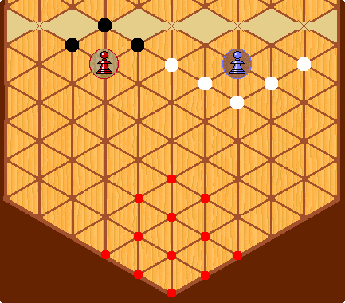 |
The General is confined to the
fortress and can only move a single orthogonal step at a
time. Generals may not face each other along an open north-south
(vertical) orthogonal. It is thus not permitted to make a move
that leaves the two
generals facing each other with no other piece in between. |
| The Guard must also stay confined
to the fortress, and can only move a diagonal single step. This gives the 2 flanking Guards to the left and right of the General just 5 possible positions, while the central Guard starting on the Palace point nearest the board's centre has only 4. |
|
| The Pawn,
while still in its own territory, can move one step along any of the
three forward facing orthogonals. Once across the central section of
the board (called 'crossing the
river') the Pawn gains the ability to move one step diagonally to the
left or right. The image on the left shows the Pawn's move, the reachable points being marked with black dots for the red Pawn and white for the blue. |
|
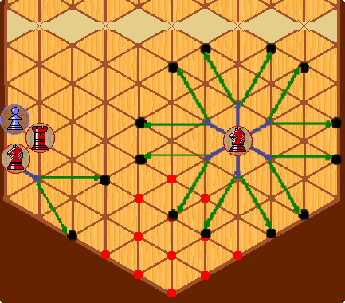 |
The Bishop moves diagonally two steps at
a time. However, bishops cannot jump over other pieces, so a
Bishop is blocked in any direction where another piece is diagonally
next to it. Bishops are defensive pieces and must stay on their
own side of the board. They may occupy a 'bridge' but cannot
cross the 'river' into enemy territory. |
| The Knight
moves by making an orthogonal step followed by a step diagonally
outward. The Knight, however, may not jump over other
pieces. If another piece is orthogonally adjacent to a Knight ,
then
that Knight cannot move in that direction. The Knight's move is shown in the diagram to the left. The innermost red Knight can reach all of the 12 points marked by a black dot, whereas the red Knight at the edge is blocked by the blue Knight and Red Rook and can only reach 2 points as indicated. The route taken by the Knight for each move is shown by the arrows: blue for the initial orthogonal step and green for the final outward diagonal step. |
|
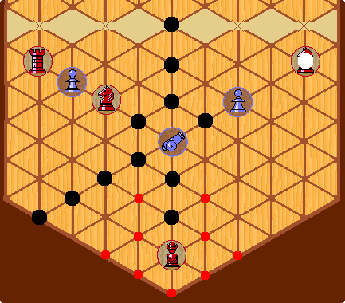 |
The Rook moves like the Rook in western
orthodox Chess, that is, any number of points orthogonally but may not
leap over other pieces. |
| The Cannon,
when not capturing, moves like a Rook, stepping any number of points
orthogonally without leaping over other pieces. The Cannon must, however, leap over another piece (of either side) in order to capture. Thus to capture an enemy piece there has to be a single intervening piece. The Cannon's move is illustrated by the diagram on the left. The blue Cannon may move to the points marked with a black dot or may capture the red Knight marked by a white dot. |
|
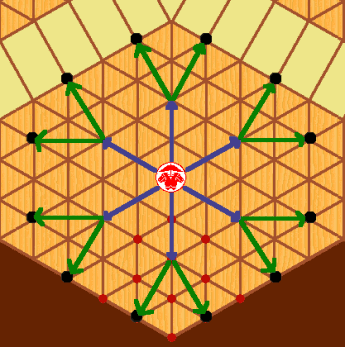 |
The Banner is an extra piece type not
found in the standard, 2- player, game of XiangQi. It moves in a manner similar to the Knight, but has an initial double orthogonal step instead of the Knight's single step. The Banner's move is illustrated by the image on the left where the red Banner can reach all 12 points marked by a black dot. The route taken by the Banner for each move is shown by the arrows: blue for the initial orthogonal double-step and green for the final outward diagonal single-step. Like the Knight, the Banner may not jump over other pieces. Thus if another piece occupies either of the two points on a Banner's initial orthogonal double-step, then that Banner cannot move in that direction. |
Notes
Directions
 As is stated in the Game of 3
Friends, "The lines of
the board are not straight throughout, and each army faces the other
two." |
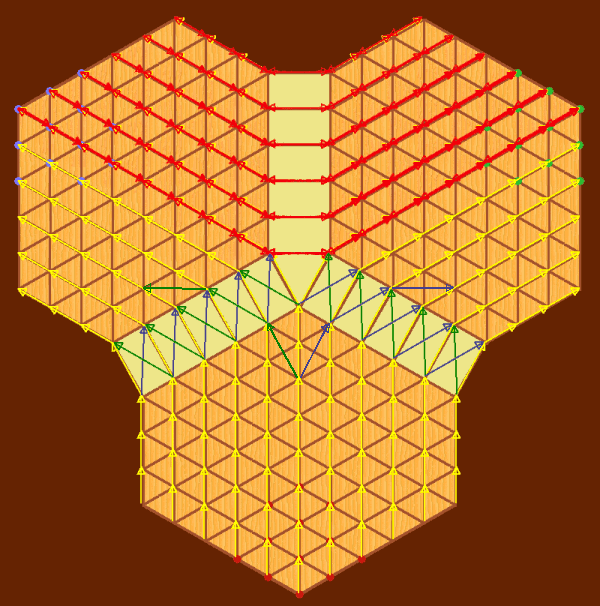 |
|
|
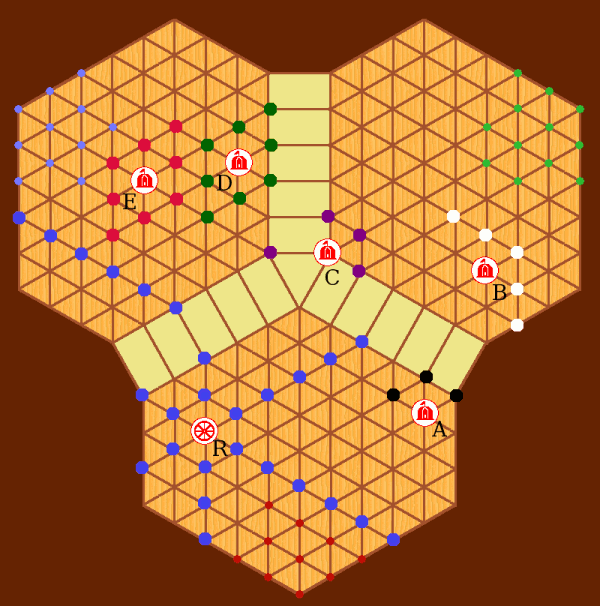 |
 This 'user submitted' page is a collaboration between the posting user and the Chess Variant Pages. Registered contributors to the Chess Variant Pages have the ability to post their own works, subject to review and editing by the Chess Variant Pages Editorial Staff.
This 'user submitted' page is a collaboration between the posting user and the Chess Variant Pages. Registered contributors to the Chess Variant Pages have the ability to post their own works, subject to review and editing by the Chess Variant Pages Editorial Staff.
By Graeme C Neatham.
Web page created: 2007-02-26. Web page last updated: 2007-02-26








